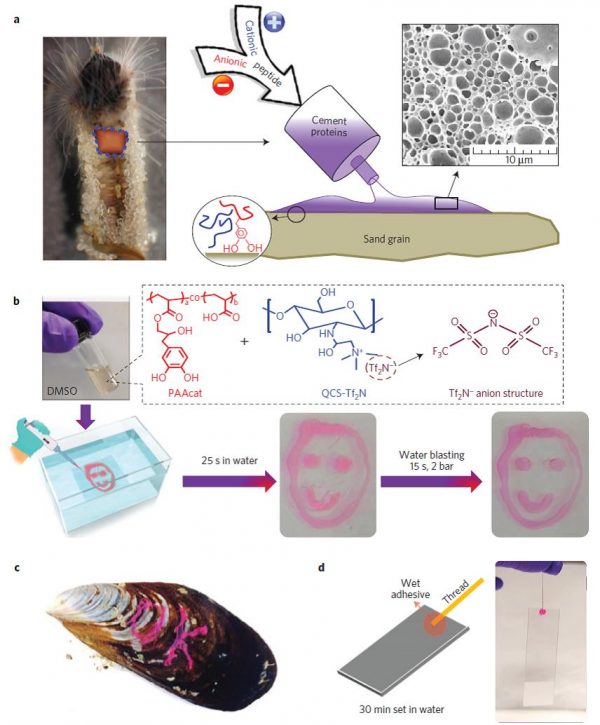一种超强生物胶水的仿生制备

Nature Materials, 2016, 15, 407-412
人们观察到贝类分泌物(蛋白质)可以把自己牢固粘在金属或者岩石的湿润表面,湿性条件下,粘合效果远远优于很多已知合成的粘合剂。 从仿生贻贝胶黏蛋白的角度出发,HerbertWaite研究小组报道了一种基于DMSO与水置换获得聚阳离子和聚阴离子静电复合物的方法,获得了25 s可在水下快速固化的超强胶水。设计的材料结构中仿生分泌物中的Mefp5(紫壳菜蛤足蛋白)主链中的DOPA(3,4-二羟基苯丙氨酸)单元,并仿生其微观结构获得海绵多孔结构如图1所示。研究发现黏结强度与水中固定时间相关,当固定时间超过临界固定时间1.5 min后,研究体系的黏结力迅速增加;当固定时间达到10 min后,黏结力达到200 mN。通过Johnson-Kendal-Roberts理论Wad = Fad/1.5pR, 获得平衡黏结能为2 J/m2. 固定10 min的样品可以经10 bar水冲击15 s后依然稳定。该材料在水下修复、生物手术等领域具有重要的应用前景。
Inspired by the chemical features of the cement proteins of the sandcastle worm, J. Herbert Waite et al. reported a versatile and strong wet-contact microporous adhesive based on electrostatic complexation. The electrostatic complexation of dissolved polycations and polyanions is triggered by solvent exchange between water and DMSO. After setting fostered for 25 s, robust underwater contact adhesion could be formed. The bio-inspired catechol chemistry as well as the porous morphology were biomimetic preparation as shown in Figure 1. After a critical setting time (about 1.5 min), the adhesion force increased sharply up to Fad 200mN at ts D 10 min, eventually reaching an asymptote of equivalent adhesion energy of Wad 2 J/m2, using Johnson_Kendal_Roberts theory. Water blasting experiments (Fig. 3c) support the SFA results; that is, longer setting times (ts = 10 min) withstood stronger blasting (10 bar) for 15 s. The combination of wet adhesion and porous structures makes the universal wet adhesive applicable, including plastics, glasses, metals and biological materials. (史新翠) |